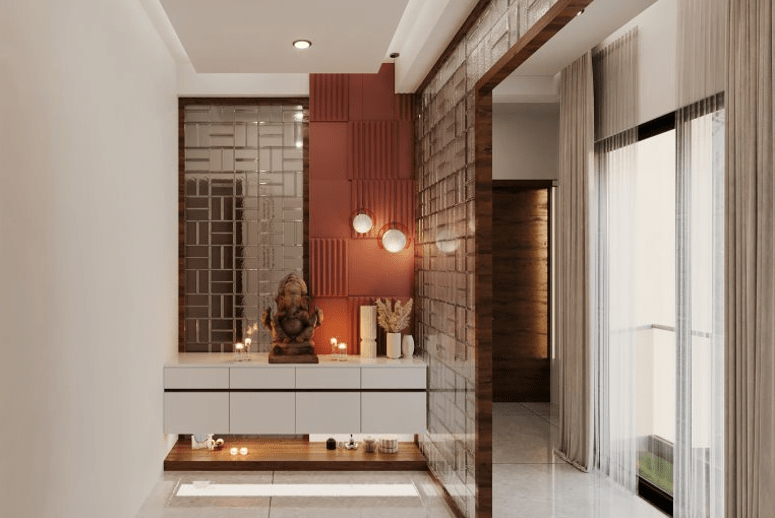A house temple or pooja room is one of the most sacred spaces in a home. It is a place of prayer, meditation, and spiritual connection. According to Vastu Shastra, the direction of the temple in a house plays a crucial role in ensuring positive energy, peace, and prosperity. Choosing the right placement can enhance harmony in the home, while an incorrect placement may lead to imbalances in energy.
In this blog, we will discuss the best house temple direction, the ideal placement within a room, things to avoid, and Vastu tips for maintaining a spiritually uplifting environment.
Table of Contents
ToggleIdeal Directions for a House Temple
1. Northeast (Ishaan Corner) – The Most Auspicious Direction
The northeast direction, also known as the Ishaan corner, is considered the most suitable location for a temple. This direction is associated with divine energy and purity, making it the best choice for spiritual activities. A temple placed in this direction helps attract positive vibrations and enhances the well-being of the residents.
2. East – The Direction of the Rising Sun
If placing the temple in the northeast is not possible, the east is the second-best option. The east is associated with the rising sun and symbolizes growth, prosperity, and renewal. Facing east while praying helps in receiving the natural energy of the sun, which is believed to enhance spiritual strength.
3. North – The Direction of Wealth and Positivity
The north direction is also considered good for a house temple. According to Vastu Shastra, the north is linked to prosperity and financial growth. Placing a temple in this direction can help attract positive energy related to success and well-being.
Directions to Avoid for a House Temple
While the northeast, east, and north are ideal for a pooja room, there are certain directions that should be avoided as they may cause energy imbalances in the home.
1. Southwest – The Zone of Stability, Not Spirituality
The southwest direction is associated with stability and strength, making it suitable for bedrooms and storage but not ideal for a temple. A temple in this direction may create obstacles in spiritual growth and personal well-being.
2. South – The Direction of Fire and Negative Energy
The south is linked with fire elements and negative influences, making it an unsuitable location for a temple. Placing a pooja room in the south may lead to disturbances in peace and harmony.
3. Southeast – The Fire Corner
The southeast direction represents the fire element and is typically reserved for the kitchen. Placing a temple here may create an imbalance in energy, which can lead to disharmony in the household.
4. Under a Staircase or Near a Bathroom
Placing a temple under a staircase or next to a bathroom is considered highly inauspicious. These areas attract negative energy and can affect the sanctity of the temple. A pooja room should always be placed in a clean and peaceful area, away from places associated with waste or heavy movement.
Placement of the Temple Within a Room
Once you have chosen the correct direction for the temple, it is essential to follow the right placement principles inside the room.
- The idols or images of gods should face west or east, so that devotees face east or north while praying. Facing east while worshipping is considered highly beneficial as it allows the person to receive positive solar energy.
- The temple should be placed on a raised platform or shelf and should never be directly on the floor. This signifies respect and maintains the sanctity of the space.
- If possible, the pooja room should have a door to keep the space pure and undisturbed. A wooden door is ideal as it adds warmth and spiritual energy.
- The space should be clean and clutter-free, as cleanliness is directly linked to positive energy in Vastu.
Vastu Tips for Enhancing the Energy of a House Temple
To ensure that your house temple radiates positive energy, follow these Vastu tips:
1. Use the Right Materials for the Temple
A wooden temple is considered the best for home use. It brings warmth, natural energy, and a spiritual ambiance. Temples made of marble are also popular, but wooden temples are more traditional and Vastu-compliant.
2. Light a Lamp Daily
A diya (oil lamp) should be lit daily in the temple to remove negative energy and attract divine blessings. The flame symbolizes knowledge, purity, and spiritual enlightenment.
3. Choose Soothing Colors for the Pooja Room
The colors of the pooja room play an important role in maintaining a peaceful atmosphere. White, yellow, light blue, or pastel shades are considered ideal. These colors create a sense of calmness and purity. Dark or very bright colors should be avoided.
4. Keep Religious Books and Items Neatly Arranged
Holy books, prayer beads, and other religious items should be kept in an organized manner. Clutter in the pooja room can block the flow of positive energy.
5. Avoid Storing Non-Religious Items in the Pooja Room
A temple should be a dedicated space for worship. Storing unnecessary items, such as household tools or non-religious books, can disturb the spiritual energy.
Conclusion
The northeast direction is the most auspicious for placing a house temple, followed by the east or north. Directions such as southwest, south, southeast, or under a staircase should be avoided to maintain a positive spiritual environment.
By following Vastu principles and simple placement guidelines, you can ensure that your house temple remains a source of peace, positivity, and divine blessings for your home.
If you are looking for expert guidance on designing a Vastu-compliant home, SmartScale House Design can help you create the perfect space for harmony and well-being.
Some Other Questions on House Temple Direction and Vastu Guidelines
1. Which direction should a home temple face?
The home temple should ideally be placed in the northeast (Ishaan) corner of the house, as this is considered the most auspicious direction according to Vastu Shastra. If the northeast is not available, the east or north direction is the next best option for placing the temple.
2. Which direction should god face at home?
The idols or images of gods should face west or east, ensuring that the person praying faces east or north while worshipping. Facing east while praying is believed to enhance positivity, spiritual growth, and divine blessings.
3. Which direction should we face while praying at home?
While praying, it is best to face east as it is associated with positivity, growth, and enlightenment. Facing north is also acceptable, as it is linked to prosperity and good fortune. Avoid facing south while praying, as it is considered inauspicious in Vastu.
4. Which facing is good for a pooja room?
The northeast is the most suitable direction for a pooja room. If this is not possible, the east or north directions are also considered good. It is best to avoid placing a pooja room in the southwest, south, or southeast as these directions may not support spiritual energy.
5. How do I choose a temple for my house?
When choosing a temple for your house, consider the following:
- Material: A wooden temple is the best option as it maintains warmth and positive energy. Marble temples are also a good choice for a luxurious look.
- Size: The temple should not be too large or too small. It should fit comfortably within the pooja room while maintaining a peaceful atmosphere.
- Design: A temple with a proper platform and space for placing idols, diyas, and holy books is ideal.
- Placement: Ensure that the temple is placed on a raised platform and not directly on the floor.
6. How to do Vastu pooja at home?
To perform Vastu pooja at home, follow these steps:
- Clean the house thoroughly, especially the northeast corner, to remove negative energy.
- Place a Vastu yantra or a copper plate with holy symbols like the Swastik or Om in the pooja room.
- Light a diya (oil lamp) in the temple to invite positive energy.
- Offer prayers and chant mantras to bring harmony and peace to the house.
- Perform a havan (fire ritual) with Vastu-compliant herbs to purify the environment.
- Keep the house well-ventilated and allow natural light to enter, especially in the pooja room.
7. Is it good to have a house opposite a temple?
Living directly opposite a temple is generally not recommended in Vastu. A house facing a temple can sometimes attract excessive spiritual energy, which may not be balanced for residential living. However, if the temple is at a reasonable distance and does not block the main entrance of the house, it is not considered a major issue. To balance the energy, a Tulsi plant or Vastu yantra can be placed at the entrance of the house.










